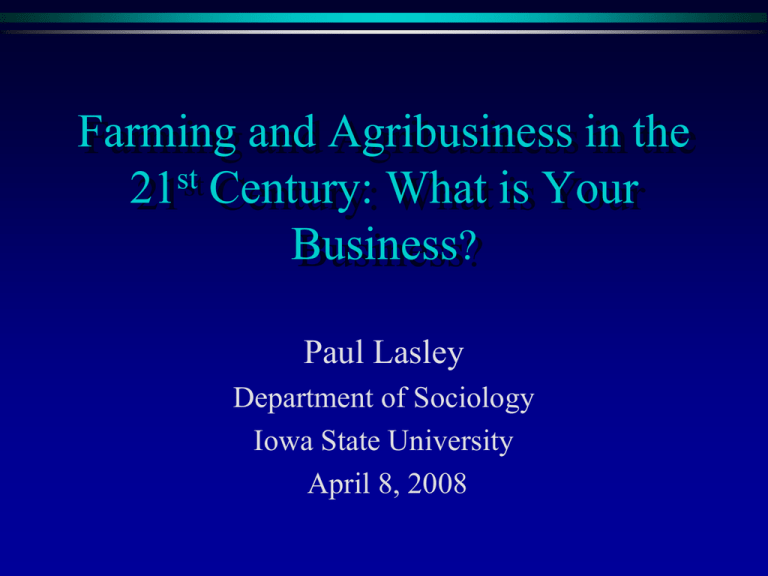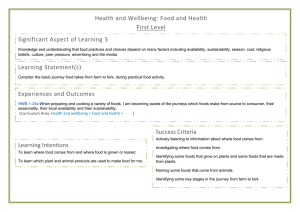Farming in the 21st Century: What is Your Business?
advertisement

Farming and Agribusiness in the 21st Century: What is Your Business? Paul Lasley Department of Sociology Iowa State University April 8, 2008 Some Observations about Predicting the Future When I’m right, no one remembers and when I wrong, no one forgets… Every generation believes they live in the MOST rapidly changing period in history… The central problem of our time is that the future is not what it used to be… What is your business? Description of your farm, such as type of practices employed, eg. feed lot, farrow to finish, row crop, or cash grain etc. Or what commodities you produce—cattle, hogs, corn, soybeans, dairy, etc . or What products you sell or services you provide… In the future… You will need to: Articulate how your business helps consumers fulfill their needs… Explain how it contributes to their overall welfare and Contributes to their basic values and beliefs How has your business changed in the last decade or so? Each of us can identify a business or industry that refused to change and hence were forced out of business. Superior performance and long term viability requires constant vigilance and willingness to change and adapt Business Success is Dependent upon: Understanding the large scale social and economic forces Positioning oneself to take advantage of the opportunities that lie ahead Learning to read the market Willingness and ability to change A major challenge of the future Ability and willingness to change to new opportunities Accepting change is not easy Thus we often ignore market information and miss opportunities Hard work is not sufficient--failure to respond to market signals What is the market telling us about the demand for: Cars without air conditioners Kerosene lanterns Slide rules Black and white television sets 8-track tape players What is the demand for the following? Undifferentiated corn/soybeans Organic fruits and vegetables Outdoor experiences (corn mazes, hayrides) Free range meat animals Rural dwelling sites What is the demand for: Grain for specialized uses (nutri-ceuticals, pharmaceuticals) Hunting preserves/hunting rights Wholesome, safe food Humanely raised livestock Agro-tourism (farmstead B&B) The Forces of Supply and Demand Price Supply Demand 0 Quantity Accepting Market Signals Too often we choose to ignore market signals and continue to produce things that the market is trying to discourage and likewise ignore opportunities where demand is growing. Why do we ignore market signals? Creatures of habit, tradition bound Change is difficult, it is uncertain, produces anxiety, uncomfortable Social and economic changes are never neutral in their impact. These changes produce gains for some and losses for others. Important Trends and Forces Influencing the Market For Food and Implications for Agribusiness 1. Re-assertion of Cultural Values and Beliefs Business ethics, especially following recent scandals on Wall Street Food safety and quality Environmental quality Changing markets and structure Animal welfare GMOs 2. Economic Restructuring Integrated food systems Increased contractual arrangements Franchises and chains Vertical integration Globalization and international competition 3. Population Shifts and Dynamics World population continues to grow US population growth strong Midwest population much slower Iowa population growth lags behind neighboring states 4. Population growth reflects opportunities Opportunities for employment Homeownership Ability to get ahead, to achieve the American dream Increased mobility, especially among the better educated and younger Iowans 5. Occupational changes Nation of employees rather than a nation of self-employed Education and skills for post-industrial workforce Dual career families, increased number of women working outside of the home Hectic lifestyles of typical two-wage earner family 6. Personal safety is becoming more important Terrorism Agro-terrorism Security systems Identity theft Safe communities, place to raise children How might these trends affect your business? Adapting your business for areas of new growth Taking on new tasks or roles, new crops, new products, new services Where growth is a potential verses where there is market saturation, and perhaps reductions are needed The need to assess where are the emerging opportunities and how you can position your business Population Change and Demand for New Foods Percent Population Change 19902000 +13.2% Population Change 19902000 Increase 13.2% or more Increase 13.1% or less +0.5 +12.4 19902000 +8.5 +9.6 +8.4 +5.4 +8.6 +8.5 +9.3 Percent Population Change 19902000 +5.4% Changes in the Food Chain Historically food production and processing was a local (home or community activity). This resulted in much diversity in terms of local food tastes and preferences, diets and habits. Examples of local cuisines: Chicken and noodles Ham hocks and beans Lukefish, kumla, and kringla Biscuits and gravy Grits or fried potatoes Cornbread and beans Bacon and eggs Tostadas, enchiladas, nachos Comfort Foods What were the special dishes (food) that your mother or grandmother baked or prepared for special occasions? Role of comfort foods— Help comfort us during sad times, Or to add a measure to celebrations Turkey at Thanksgiving, lamb at Easter, homemade ice cream and apple pie, etc What do you suppose are the comfort foods for young people today? Pizza Hamburger and fries Finger food, eg (chicken tenders) Peanut butter and jelly DQ Smoothie Etc. So what happened? Development of the refrigerated railroad cars, refrigerated trucks and refrigerator ships long distance hauling of foods from across the country supermarkets Greater selection, available throughout the year, demise of local food system What producers told us about trends in the food system (1999 Farm and Rural Life Poll) 89% Food safety will become more important 73% Consumers will become more concerned about origins and safety 70% new opportunities will emerge for farmers 53% population growth will heighten demand Local food production 71% have a garden Estimate that about 20% of food is produced on their farm 40% have fruit trees 9% raise their own eggs 13% raise chickens for butchering 32% raise cattle for own freezer 23% raise hogs for own freezer 67% can, freeze or dry vegetables Farmers’ concern about food safety % Very or Somewhat Food from your local supermarket 71 Natural or organic food stores 55 Local farmers markets 52 Direct purchases from producers 50 Consumer Driven Agriculture Demand for farm products will increase as population increases Demographic shifts—shifts in food tastes and preferences Increasing per capita income will reward quality Consumer Driven Agriculture Aging baby boomers, those born between 1946-64 will approach 54 million by 2020 Market growth and potential for older population, less active, higher standard of living More expensive cuts of meat, exotic vegetables, luxury food items, ready to eat, higher priced restaurants, etc. Consumer Driven Agriculture Per capita income growth is projected to be about 1% annually between 2000-2020, compared with 1.2% that occurred between 1988-98 Key question is how much of this higher disposable income will be spent on food and what types of food will be demanded Consumer Driven Agriculture Projections are: More fruit, vegetables, fish, poultry, cheese, yogurt and prepared foods More eating out More attention to diets, health and wellness Consumer Driven Agriculture Population projections Hispanics Asians Whites Blacks 2002 12.6% 3.9% 71.0% 12.0% 2020 18% 5.0% 64.0% 13.0% U.S. population stands at 281 million and by 2020 will grow to about 331-361 million (50-80 million). In addition to the new demands from consumer.. Agriculture will be expected to be a source of: FOOD FEED FUEL FIBER INDUSTRIAL COMPOUNDS Farming in the 21st Century Quality, quality, quality Traceability Country of origin labels (COOL) Connections between producers and consumers Environmental friendly Learn from others—study Don’t run in the herd Success is more than money Develop priorities and keep a sense of balance Enjoy life In this changing marketplace and culture, it is important that we better communicate and connect with consumers, explain what we do, and equally important, why.






